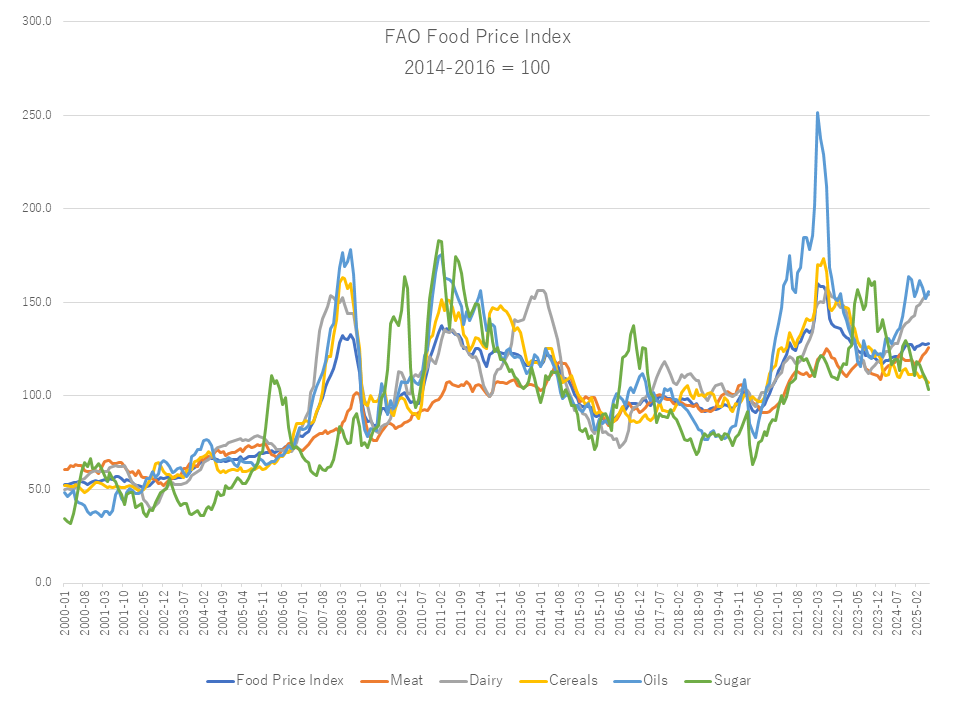Pick Up
1292. World Food Price Trends in June 2025

1292. World Food Price Trends in May 2025
The Food and Agriculture Organization of the United Nations (FAO) announced the world food price trend on July 4, with the average for June 2025 being 128.0 points, up 0.5% from May. The decline in the cereal and sugar price indexes was outweighed by increases in the dairy, meat, and vegetable oil price indexes. Overall, the price index was 5.8% higher than in June 2024, but remained 20.1% lower than the peak recorded in March 2022.
The Cereal Price Index was at 107.4 points, down 1.5% from May and 6.8% from a year ago. World corn prices fell sharply for the second consecutive month as seasonal increases in supplies from Argentina and Brazil intensified competition between the main export-producing regions. World prices for sorghum and barley also fell in June. In contrast, international wheat prices rose month-on-month, despite harvest pressure from the Northern Hemisphere. This mainly reflects weather concerns in major producing regions, including the Russian Federation, parts of the European Union (EU), and the United States. The rice price index fell 0.8% on weak demand for indica varieties.
The Vegetable Oil Price Index averaged 155.7 points in June, up 2.3% from the previous month and 18.2% above its June 2024 level. The increase mainly reflected higher palm, rapeseed, and soybean oil prices, which more than offset a slight decline in sunflower oil prices. International palm oil prices increased by about 5% in June, mainly supported by solid global import demand on the back of stronger price competitiveness. Soybean oil prices also rose in June on expectations of increased feedstock demand from the biofuel sector following announcements of support measures in Brazil and the United States. Rapeseed oil prices rose on expectations of continued tight global supplies in 2025/26. Meanwhile, sunflower oil prices fell on expectations of increased production in the Black Sea region.
The FAO Meat Price Index averaged 126.0 points in June, up 2.1% from the previous month and 6.7% from a year ago, hitting a new record high, reflecting increases in all meat prices except chicken. Beef prices reached new highs, reflecting tight export supplies from Brazil and strong demand from the United States. Meanwhile, poultry prices continued to decline, pushed by a domestic supply glut in Brazil, where highly pathogenic avian influenza (HPAI) was confirmed in mid-May and export restrictions were introduced. However, the impact was partially reversed in the second half of the month as Brazil regained HPAI-free status after 28 days of no new cases on commercial farms, some trading partners relaxed restrictions, and import demand gradually recovered.
The FAO Dairy Price Index rose 0.5% from the previous month and 20.7% from a year ago. The continued upward trend in the Butter Price Index was driven by continued tight supplies, mainly in Oceania and the European Union, as well as strong import demand from Asia, including the Near East.
The FAO Sugar Price Index fell 5.2% from May, its fourth consecutive monthly decline. This is the lowest level since April 2021, when it recorded an average of 100.0 points. The decline was mainly driven by an improving supply outlook in major producing countries.
Contributor: IIYAMA Miyuki, Information Program
